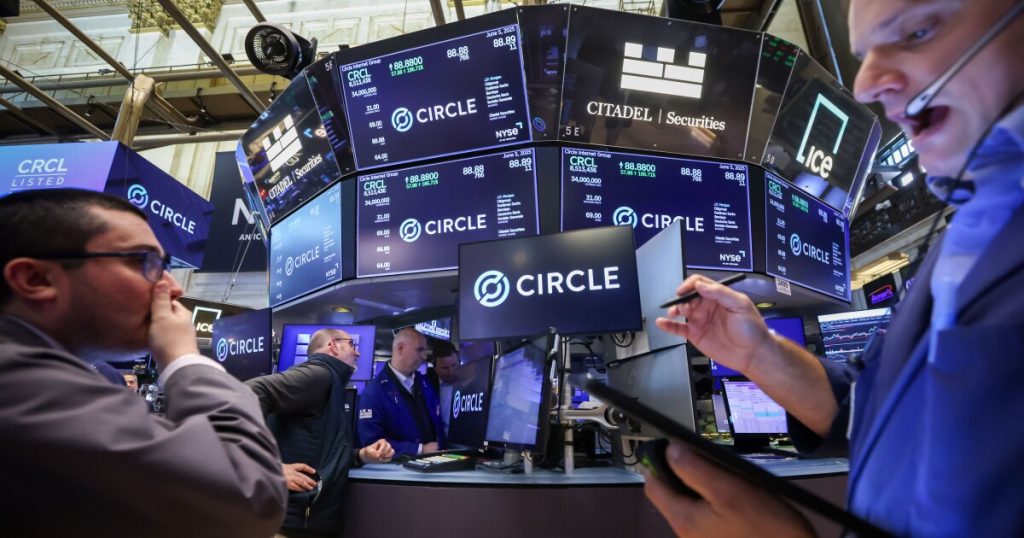A surge in shares of Circle Internet Group, lifted by a wave of optimism about U.S. stablecoins, has investors and market-watchers alike wondering just how much upside could be left in the near term for the newly publicly traded company.
The blistering rally started on the first day of trading for the company behind USDC, the second-largest stablecoin by market share, when the stock more than doubled from its initial public offering price of $31. Since its debut on June 5, the stock has continued to march higher, with shares gaining 9.6% Monday to close at $263.45.
Circle has been the main beneficiary of euphoria around
In mid-June, the Senate passed legislation setting up regulations for the U.S. dollar-pegged cryptocurrencies in a landmark win for both the crypto industry and President Donald Trump, whose affiliated stablecoin with World Liberty Financial already boasts a roughly $2 billion market value. The House has also been pursuing its own legislation.
Other companies have joined the ride. Shares of Fiserv rose 4.4% on Monday after the financial tech company said it plans
Even with the recent momentum, if stablecoins don’t become a widely used and accepted payment method, there could be limited potential for Circle going forward.
“We are highly skeptical stablecoins will ever be a relevant payment method in the U.S. The current card-based system works: it’s convenient, secure and rewards-rich,” Jefferies analyst Trevor Williams wrote in a Monday note, adding that stablecoins might lead to a clunky consumer experience and not offer many new discounts or reward incentives.
“For U.S. consumers, we also don’t see a compelling reason to hold USDC other than in a wallet as the on/off-ramp into crypto trading,” Williams said.
While some see Circle as being able to compete with the likes of Visa and Mastercard, RIA Advisors portfolio manager Michael Lebowitz isn’t so sure. He views stablecoins as offering a similar service to money-market funds for people who are buying and selling cryptocurrencies.
“I’m not sold that it’s really going to kill Visa or hurt Visa because a lot of that money in cryptocurrency was not going to be used,” Lebowitz said.
Other risks
In addition, some of Circle stock’s gains may be aided by low free float, or the number of shares available to trade. Its free float is just 25%, compared with an average of 95% for companies in the S&P 500 Index. Low float can add volatility to trading and lead to outsized moves in price. While this might be helping Circle’s rally to the upside, it could also weigh on the stock to the downside if sentiment reverses.
The rally has also made shares expensive, pushing its price-to earnings ratio near 180, a premium to the broader S&P 500 which trades at about 22 times forward earnings. Gilgamesh Ventures founding partner Miguel Armaza sees Circle’s high PE ratio compared with its peers as only being sustainable if the company materially boosts net margins and earnings over the next year.
“Any execution hiccups, unexpected regulatory setbacks or macroeconomic headwinds could easily compress the company’s multiples, bringing Circle’s valuation down closer to its peers,” Armaza said.
Of course, there are signs that the stablecoin market will continue to grow. Circle said in April that it would launch a payments network to help financial institutions settle cross-border transactions in stablecoins, and this month, Shopify said it would roll out USDC payments for merchants and customers globally.
U.S. bipartisan support and new legislation will lead to demand for stablecoins, and Circle already has a head-start to address that, according Strahinja Savic, head of data and analytics at FRNT Financial. The company also benefits from retailers looking for cost savings and investors seeking increased exposure to crypto on public markets, Savic said.
“In this context, the stars have aligned for stablecoins, and we’re seeing that translate into remarkable performance for Circle,” he said.

